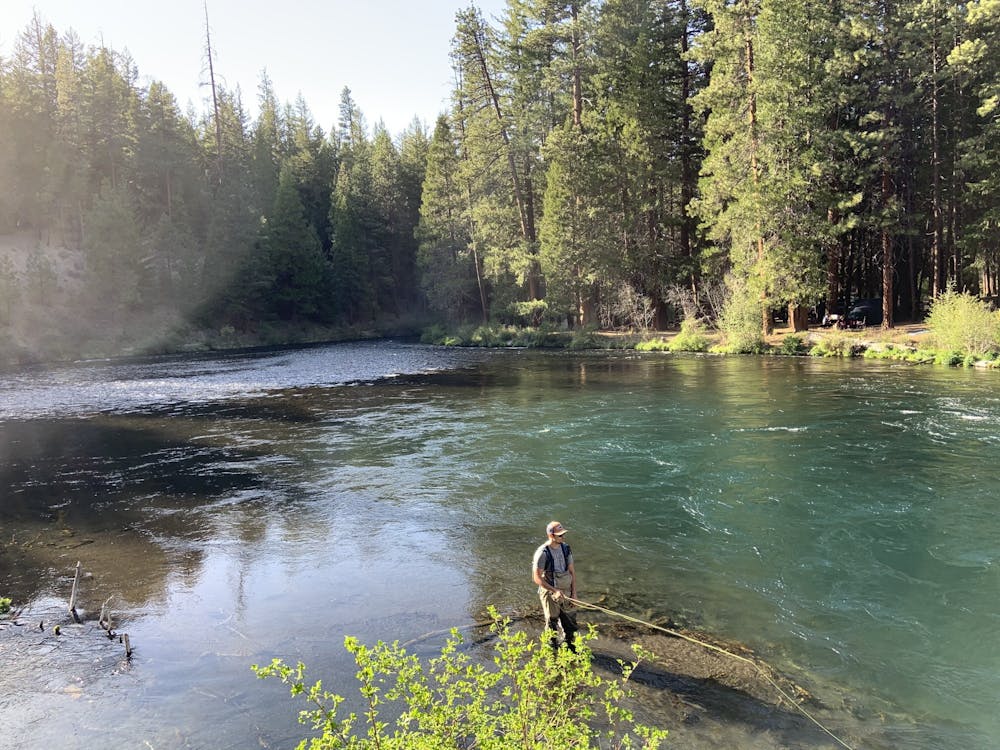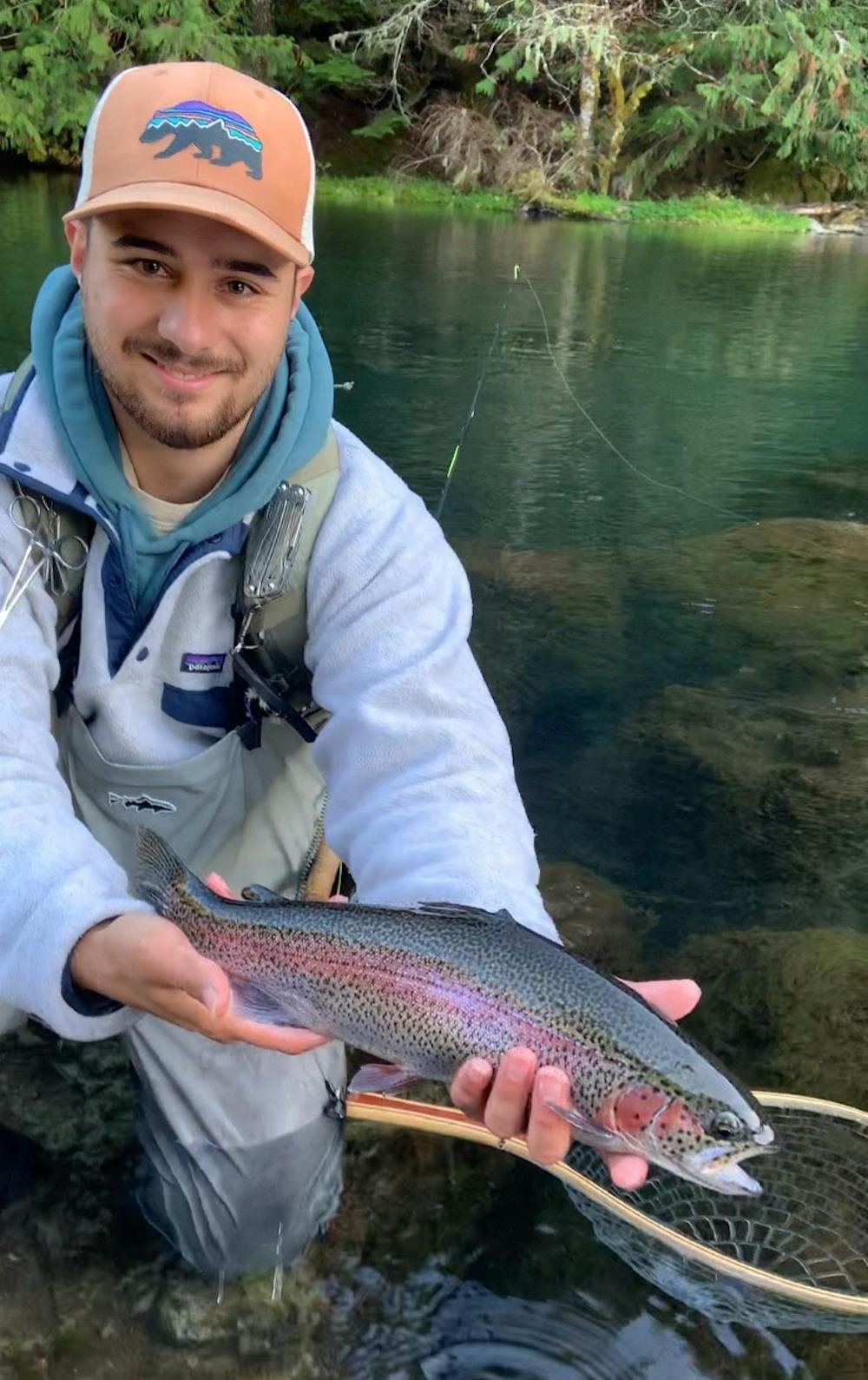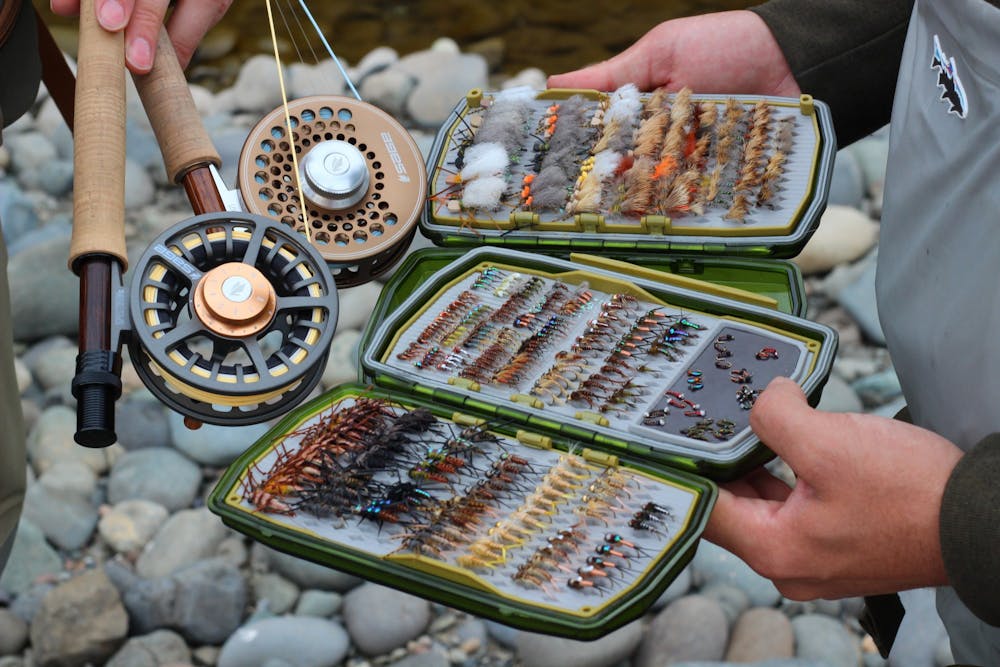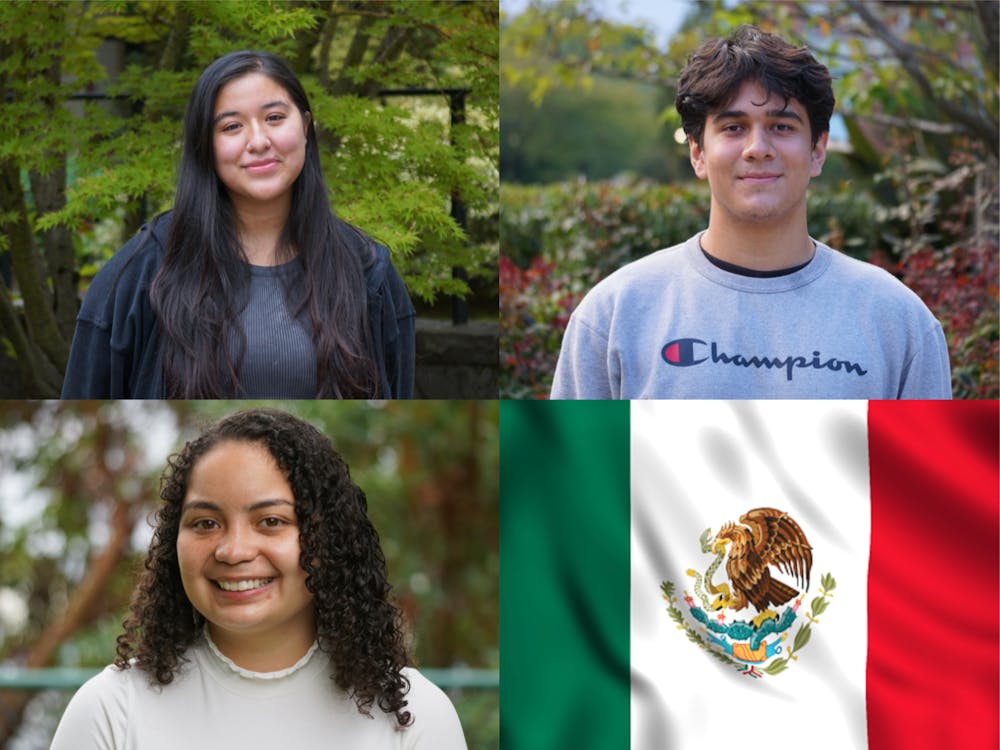One fly fishing trip was all it took for Curtis Jones to be hooked immediately.
“Pun not intended,” Curtis Jones, a senior, said.
It all began the summer after their freshman year of college when Curtis Jones decided to try fly fishing — a method of fishing where an artificial light-weight fly, resembling an invertebrate, is cast out on/near the surface of the water to catch fish.
He bought a cheap rod and reel and ventured out to the Wilson River himself.

Adam watches his brother Curtis cast while fly fishing for Oregon's world-famous trout.
Photo courtesy of the Jones twins
Out on the river, his only focus on the mesmerizing sight of the drifting artificial fly and the wild fish swimming below, Jones was in a state of bliss.
One month later, Curtis took along his identical twin Adam Jones, who felt an instant connection as well.
“We’ve heard people say that once you get into it, it’s your hobby for the rest of your life,” Curtis Jones said.
Curtis, a civil engineering major, and Adam, a mechanical engineering major, are both in their fourth year at UP in the selective Multiple Engineering Program Co-op (MECOP).
For the Jones twins, however, fly fishing has evolved into more than just a hobby. It has become the thing they wake up thinking about, look forward to doing on the weekend, and talk about during the week. Fly-fishing has even become the focus of their career paths.
“It’s just when you’re there, nothing else matters and you never want to leave ” Adam said.
Growing up, Curtis and Adam spent lots of time together and enjoyed being near rivers. They did lots of camping, hiking and conventional fishing, but never fly fishing.
It is no surprise that the twins are completely self-taught in fly fishing — aside from wise men they’ve met on the river who offer up tips. It is also no surprise to learn that they quickly developed a unique talent for fly-tying, an intricate method of making artificial flies by binding materials to a hook with a thread to replicate the fish’s prey. It requires skilled hands and patience.
As kids, Curtis and Adam said they were constantly using their hands to create and put their own artistic touch on things.
“I knew they were both artistically talented from a young age,” their dad, Greg Jones, said.

A meandering river is captured through oil on canvas by Curtis. Curtis often paints the rivers he fly fishes.
Photo courtesy of the Jones twins
Curtis, who has prolific oil landscape paintings displayed in wineries in the Willamette Valley and sold at art shows, was instantly inspired to paint the rivers where he goes fly fishing. His paintings are one way to express his love of rivers.
“Fly-tying for me is pretty much the same as painting,” Curtis said. “It’s the same creative process.”
Adam loves fly-tying as well as it allows you to create a pattern or fly that has never been made before, he said. He thinks it’s really rewarding when you tie a fly and it works, especially when it’s a pattern that he and Curtis made together. It also saves them a bit of money.
The Jones twins often use fly fishing entomology, the study of insects, to decide which flies to tie according to which insects the fish are feeding on. They flip over a rock in the river to observe which insects are there, and then tie flies based on the insect they’re trying to imitate, keeping in mind the color, size, presence of legs, etc.
“Part of the fun is figuring out which flies are working and which aren’t,” Adam said.
Although they go fly-fishing individually at times, they love going together to figure out what’s working as a team and help each other spot fish, Adam said.
“Sometimes when the water is really clear and you can see the fish moving, I’ll stand up on a ridge and tell Curtis exactly where to cast,” Adam said.

Adam uses waders to fish a seam in the Metolius.
Photo courtesy of the Jones twins
Curtis’ first MECOP internship with the Oregon Department of Transportation’s construction office in Astoria allowed him to solo fly-fish frequently at a creek by his home where he became fascinated with learning its details. Curtis appreciates being out there by himself, casting melodic strokes in the river, and often not talking to anyone all day.
This experience, along with being introduced to a new subset of civil engineering, changed his career path.
“When I was introduced to water resources engineering, specifically stream restoration, nothing else in civil engineering mattered,” Curtis said. “I knew I wanted to do this.”
Fly fishing similarly changed Adam’s career focus. Adam started at UP as a mechanical engineering major with an interest in clean energy. Fly fishing sparked his interest in hydropower, as it’s a renewable source of energy, but creates problems for fish, he said.
“If I had a goal in my career, it would be to improve hydropower for humans, but also make it more fish-safe,” Adam said.
Next fall, Adam will be interning at Portland General Electric working with their hydropower plants. Curtis will be interning at AECOM working on stream restoration.
“It’s so spectacular to see them transition their passion of fly fishing into their academic careers,” Greg Jones said.
Mechanical Engineering Assistant Professor and avid fly fisher, Jordan Farina, is inspired to see young people like Adam and Curtis who are passionate about fly-fishing and advocating for the conservation of rivers and native fish.

Curtis shows off a rainbow trout he caught on this fly rod.
Photo courtesy of the Jones twins
“Curtis and Adam are exactly what we need,” Farina said. “People that care about something and then take that pursuit to the next level and build their careers off of it. I’m not always the most optimistic, but it’s nice to hear stories like Curtis and Adam’s.”
Although they started out in rivers near Portland, they have slowly ventured further into places they never would have gone if not for fly fishing, Adam said. Their favorite rivers to fly fish on are the Deschutes and the Metolius. Coastal rivers, like the Trask, Wilson, and Kilchis, and local rivers such as the Clackamas are ones they frequent as well. They feel lucky living so close to great fly fishing rivers, Adam said.
Their love of fly fishing isn’t just the act itself. A typical day includes waking up around 4:30 or 5 a.m. on a Saturday morning, driving two hours, hiking an hour to a good spot in the river, and then fishing all day. They enjoy every single part of it.
Some fly-fishers catch-and-release and some catch-and-keep. The twins mostly catch-and-release. They like to admire and appreciate the fish when they catch one and are careful not to harm them, using barbless hooks and keeping them in the water when not handling them.
The feeling of holding a fish in his hands and having a tangible connection to the wildness of the place is one of Curtis’s favorite parts of fly fishing. For Adam, walking up to a perfect body of water that looks “fishy” and then watching the fly drifting over the water as the fish swims to the surface is incredibly satisfying.
The twins catch a variety of trout, from redside rainbows native to central Oregon to coastal cutthroat trout. They would like to get into salmon fly fishing once they have the gear to do so.
They can’t help but feel a connection to the wilderness and history of the river when they catch a fish that is native to Oregon.
“It’s really special to be able to interact with a species that was here way before we were and has battled everything to survive,” Curtis said. “When I’m sleeping, I always find myself thinking about how the river never stops flowing and how when you see a salmon swim past you and you think about how far it has swam to come back to the same place it started in, and it’s just crazy to think about.”

Adam draws his fly out of the water as he recasts. The Jones twins fish all over Oregon, especially in the Columbia River watershed.
Photo courtesy of the Jones twins
While most fly fisher’s are between the ages of 25-52 years, Curtis and Adam are uniquely young to be seasoned fly-fishers already — not to mention fly-tiers as well. Many young people don’t start fly fishing because they haven’t been exposed to it yet, and the gear can be expensive initially, the Jones twins said.
“I think the cool part about being young and in this sport is that older guys who have been fishing the same river their entire life will see us and want to give us so many tips and lessons,” Curtis said. “That’ll be us when we’re 70, still fly-fishing.”
In their 70’s they hope to have also made many advancements to conserve the river ecosystems and fish they care so deeply about as well as inspiring others to align their passions with their careers as well.
“We’re going out to the McKenzie River this weekend to fly fish, and not that I don’t like school or my classes, but going there to fish is all I can think about this week,” Adam said.
Sophia Truempi is a reporter for The Beacon. She can be reached at truempi22@up.edu.








